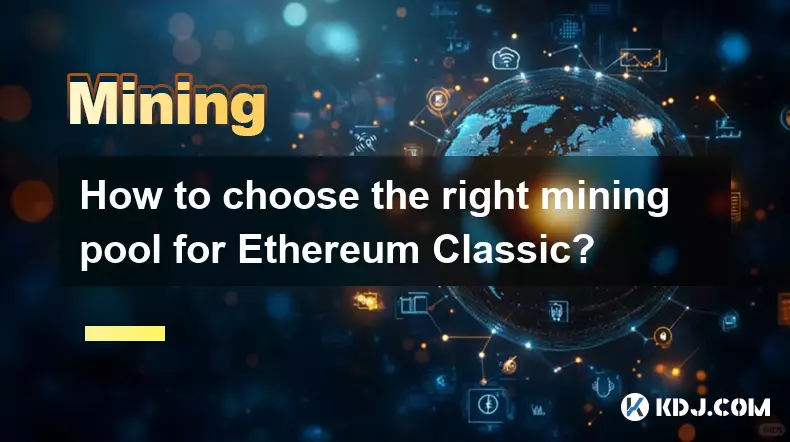-
 bitcoin
bitcoin $114320.977035 USD
-0.40% -
 ethereum
ethereum $4152.439985 USD
-1.75% -
 tether
tether $1.000111 USD
-0.04% -
 xrp
xrp $2.843037 USD
-1.63% -
 bnb
bnb $1013.349380 USD
-1.62% -
 solana
solana $208.362767 USD
-2.10% -
 usd-coin
usd-coin $0.999783 USD
0.00% -
 dogecoin
dogecoin $0.232559 USD
-1.00% -
 tron
tron $0.333491 USD
-1.09% -
 cardano
cardano $0.806310 USD
0.19% -
 hyperliquid
hyperliquid $45.023720 USD
-1.59% -
 ethena-usde
ethena-usde $1.000819 USD
-0.06% -
 chainlink
chainlink $21.241249 USD
-2.11% -
 avalanche
avalanche $30.035416 USD
-0.66% -
 stellar
stellar $0.364984 USD
-2.05%
How to choose the right mining pool for Ethereum Classic?
Ethereum Classic mining pools boost profitability by combining hash power, with key factors including fees, payout models, uptime, and security.
Sep 01, 2025 at 08:18 am

Understanding Ethereum Classic Mining Pools
1. Ethereum Classic operates on a proof-of-work consensus mechanism, making mining a critical component of its network security and transaction validation. Miners contribute computational power to solve complex cryptographic puzzles, and in return, they receive block rewards. Since individual miners often lack sufficient hash power to mine blocks independently, they join mining pools to combine resources and increase their chances of earning rewards.
2. A mining pool is a coordinated group of miners who work together and share the rewards proportionally based on contributed work. Choosing the right pool directly affects mining efficiency, payout consistency, and overall profitability. Factors such as pool fees, payout methods, server stability, and geographic location play a crucial role in determining the best fit for a miner’s setup.
3. Transparency is another essential aspect. Reliable pools provide real-time statistics, detailed dashboards, and clear documentation about their operations. Miners should look for pools that publish their hash rate, recent blocks found, and uptime history. This visibility helps build trust and allows miners to verify the pool’s performance independently.
4. The reputation of a mining pool within the Ethereum Classic community also matters. Long-standing pools with positive feedback from users tend to offer more stable and secure environments. Community forums, Reddit threads, and mining discussion boards are useful places to research user experiences and identify potential red flags.
Key Metrics to Evaluate Mining Pools
1. Pool fees significantly impact net earnings. Most Ethereum Classic pools charge between 0% and 2.5% of the block reward as a service fee. Lower fees are generally better, but they should not come at the expense of reliability or security. Some pools offer zero fees in exchange for less frequent payouts or reduced support.
2. Payout structures vary across pools. Common models include Pay-Per-Share (PPS), Proportional, and Pay-Per-Last-N-Shares (PPLNS). PPS offers steady income but usually comes with higher fees. PPLNS rewards loyalty and consistent participation but can result in fluctuating payouts depending on the pool’s luck in finding blocks.
3. Uptime and server responsiveness are critical for uninterrupted mining. A pool with frequent downtime or high ping can lead to stale shares and reduced efficiency. Miners should choose pools with geographically close servers to minimize latency and maximize submission speed.
4. Hash rate distribution across the network is another consideration. Joining a pool that controls an excessively large portion of the network hash rate could pose centralization risks. Ideally, miners should support pools that maintain a healthy share—below 30%—to preserve the decentralization ethos of Ethereum Classic.
Security and Operational Transparency
1. Secure connections are non-negotiable. The mining pool should support encrypted protocols like stratum+ssl or TLS to protect data transmission between the miner’s rig and the pool’s servers. Unencrypted connections expose miners to man-in-the-middle attacks and potential hijacking of hash power.
2. Two-factor authentication (2FA) and strong account protection features help prevent unauthorized access to mining accounts. Pools that offer 2FA, IP whitelisting, and detailed login logs provide an additional layer of defense against credential theft and payout redirection.
3. Open-source pool software or publicly audited codebases enhance trust. When a pool’s backend or frontend code is available for inspection, it reduces the risk of hidden backdoors or unfair reward distribution algorithms. Some pools even publish their financial records to demonstrate fair operations.
4. Regular updates and active maintenance indicate a committed development team. Pools that promptly address bugs, adapt to network changes, and communicate outages effectively are more likely to remain operational during network upgrades or forks.
Top Ethereum Classic Mining Pools in Practice
1. Ethermine, though primarily known for Ethereum, has maintained support for Ethereum Classic and offers a user-friendly interface with low fees and reliable payouts. It provides detailed analytics and integrates well with popular mining software.
2. Nanopool is another widely used option, known for its global server coverage and support for multiple cryptocurrencies, including Ethereum Classic. It uses a PPLNS model and has a reputation for stability, though its fee structure includes a 1% charge plus transaction fees.
3. Flypool, operated by Flexpool, emphasizes transparency and decentralization. It offers zero pool fees and relies on voluntary donations. Its infrastructure is distributed, reducing single points of failure, and it provides real-time monitoring tools for miners.
4. MiningPoolHub, while supporting a wide array of coins, allows miners to auto-switch to the most profitable algorithm, including ETC. This flexibility benefits miners with multi-algorithm rigs, though it may lead to less predictable ETC-specific earnings.
Frequently Asked Questions
What is a stale share, and how does it affect mining profitability?A stale share is a valid proof-of-work submission that arrives too late to be counted, usually due to high latency or pool server delays. Accumulating stale shares reduces effective hash rate and lowers reward potential. Choosing a low-latency pool minimizes this issue.
Can I switch mining pools without losing my accumulated shares?No, accumulated shares are not transferable between pools. Each pool tracks work independently. When switching, miners start fresh with zero shares. However, pending payouts from the original pool will still be processed according to its payout threshold and schedule.
Do mining pools provide API access for monitoring?Yes, most reputable Ethereum Classic mining pools offer RESTful APIs that allow miners to retrieve real-time data on hash rate, worker status, recent payouts, and pool statistics. These APIs can be integrated into custom dashboards or monitoring tools.
How often are rewards distributed by typical Ethereum Classic pools?Payout frequency depends on the pool’s configuration and the miner’s hashrate. Some pools distribute rewards daily or when a threshold is reached, while others use automatic payments once the balance exceeds a minimum amount, such as 0.1 ETC.
Disclaimer:info@kdj.com
The information provided is not trading advice. kdj.com does not assume any responsibility for any investments made based on the information provided in this article. Cryptocurrencies are highly volatile and it is highly recommended that you invest with caution after thorough research!
If you believe that the content used on this website infringes your copyright, please contact us immediately (info@kdj.com) and we will delete it promptly.
- BlockDAG, DOGE, HYPE Sponsorship: Crypto Trends Shaping 2025
- 2025-10-01 00:25:13
- Deutsche Börse and Circle: A StableCoin Adoption Powerhouse in Europe
- 2025-10-01 00:25:13
- BlockDAG's Presale Buzz: Is It the Crypto to Watch in October 2025?
- 2025-10-01 00:30:13
- Bitcoin, Crypto, and IQ: When Genius Meets Digital Gold?
- 2025-10-01 00:30:13
- Stablecoins, American Innovation, and Wallet Tokens: The Next Frontier
- 2025-10-01 00:35:12
- NBU, Coins, and Crypto in Ukraine: A New Yorker's Take
- 2025-10-01 00:45:14
Related knowledge

The difference between staking and mining
Sep 24,2025 at 05:18am
Understanding Staking in the Cryptocurrency Ecosystem1. Staking involves holding funds in a cryptocurrency wallet to support the operations of a block...

How to participate in testnet mining?
Sep 22,2025 at 09:18am
Understanding Testnet Mining in the Crypto Ecosystem1. Testnet mining is a method used by blockchain developers to simulate real-world conditions on a...

How to dispose of abandoned mining machines?
Sep 19,2025 at 08:19pm
Assessing the Condition of Abandoned Mining Rigs1. Begin by inspecting each mining machine for visible damage, corrosion, or missing components. Machi...

How to identify high-quality mining pools?
Sep 21,2025 at 03:19pm
Reputation and Track Record1. A mining pool’s reputation is built over time through consistent performance and transparency. Pools that have operated ...

Advantages of decentralized mining pools
Sep 20,2025 at 04:36pm
Enhanced Security and Resistance to Censorship1. Decentralized mining pools operate on blockchain-based smart contracts, eliminating the need for a ce...

What is mining machine overclocking?
Sep 21,2025 at 07:19pm
Understanding Mining Machine Overclocking1. Mining machine overclocking refers to the process of increasing the operating frequency of a cryptocurrenc...

The difference between staking and mining
Sep 24,2025 at 05:18am
Understanding Staking in the Cryptocurrency Ecosystem1. Staking involves holding funds in a cryptocurrency wallet to support the operations of a block...

How to participate in testnet mining?
Sep 22,2025 at 09:18am
Understanding Testnet Mining in the Crypto Ecosystem1. Testnet mining is a method used by blockchain developers to simulate real-world conditions on a...

How to dispose of abandoned mining machines?
Sep 19,2025 at 08:19pm
Assessing the Condition of Abandoned Mining Rigs1. Begin by inspecting each mining machine for visible damage, corrosion, or missing components. Machi...

How to identify high-quality mining pools?
Sep 21,2025 at 03:19pm
Reputation and Track Record1. A mining pool’s reputation is built over time through consistent performance and transparency. Pools that have operated ...

Advantages of decentralized mining pools
Sep 20,2025 at 04:36pm
Enhanced Security and Resistance to Censorship1. Decentralized mining pools operate on blockchain-based smart contracts, eliminating the need for a ce...

What is mining machine overclocking?
Sep 21,2025 at 07:19pm
Understanding Mining Machine Overclocking1. Mining machine overclocking refers to the process of increasing the operating frequency of a cryptocurrenc...
See all articles










































































